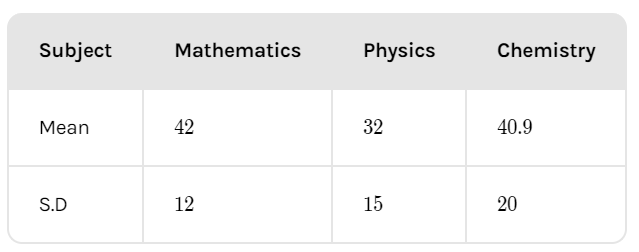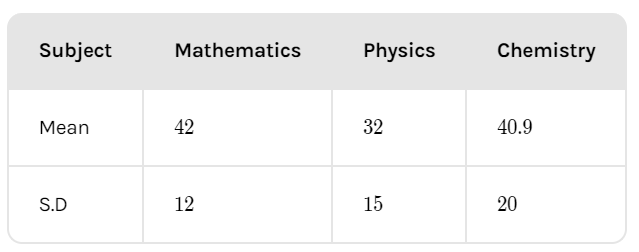
The mean and S.D of marks obtained by 50 students of a class in three subjects, mathematics, physics, and chemistry are given below:

Which of the three subjects shows the lowest coefficient of variation?

Answer
582k+ views
Hint: The coefficient of variation is given by the formula \[C.V=\dfrac{S.D}{mean}\times 100\], here S.D is the standard deviation and the mean is the average of all the data. C.V is the coefficient of variation of the data set whose mean and standard deviation is given for different subjects.
Complete step-by-step answer:
In the question, it is given that the mean and S.D of marks obtained by 50 students of a class in three subjects, mathematics, physics, and chemistry are as follows:

Now, we have to find the subject with the lowest coefficient of variation. So here we know that the higher the coefficient of variation, more is the deviation from the mean of the data. The standard deviation is the measure that gives the percentage of data that lies around the mean. Also, we know that the mean is the average of the data given.
Now the formula that we use to find the coefficient of variation is given as: \[C.V=\dfrac{S.D}{mean}\times 100\].
Here, S.D is the standard deviation and the mean is the average of all the data. Also, C.V is the coefficient of variation. So, we will find the coefficient of variation of each subject as shown below:
Coefficient of variation for Mathematics is:
\[\begin{align}
& \Rightarrow C.V=\dfrac{S.D}{mean}\times 100 \\
& \Rightarrow C.V=\dfrac{12}{42}\times 100 \\
& \Rightarrow C.V=28.57 \\
\end{align}\]
Similarly, Coefficient of variation for Physics is:
\[\begin{align}
& \Rightarrow C.V=\dfrac{S.D}{mean}\times 100 \\
& \Rightarrow C.V=\dfrac{15}{32}\times 100 \\
& \Rightarrow C.V=46.875 \\
\end{align}\]
Similarly, Coefficient of variation for Chemistry is:
\[\begin{align}
& \Rightarrow C.V=\dfrac{S.D}{mean}\times 100 \\
& \Rightarrow C.V=\dfrac{20}{40.9}\times 100 \\
& \Rightarrow C.V=48.89 \\
\end{align}\]
So now, we can see that Mathematics shows the lowest coefficient of variation, i.e, \[C.V=28.57\].
Note: It can be noted that the coefficient of variation is very different from the variance. The variance is the squared of standard deviation, S.D. Also, be careful to multiply the ratio \[\dfrac{S.D}{mean}\] by 100 when we are finding the coefficient of variation.
Complete step-by-step answer:
In the question, it is given that the mean and S.D of marks obtained by 50 students of a class in three subjects, mathematics, physics, and chemistry are as follows:

Now, we have to find the subject with the lowest coefficient of variation. So here we know that the higher the coefficient of variation, more is the deviation from the mean of the data. The standard deviation is the measure that gives the percentage of data that lies around the mean. Also, we know that the mean is the average of the data given.
Now the formula that we use to find the coefficient of variation is given as: \[C.V=\dfrac{S.D}{mean}\times 100\].
Here, S.D is the standard deviation and the mean is the average of all the data. Also, C.V is the coefficient of variation. So, we will find the coefficient of variation of each subject as shown below:
Coefficient of variation for Mathematics is:
\[\begin{align}
& \Rightarrow C.V=\dfrac{S.D}{mean}\times 100 \\
& \Rightarrow C.V=\dfrac{12}{42}\times 100 \\
& \Rightarrow C.V=28.57 \\
\end{align}\]
Similarly, Coefficient of variation for Physics is:
\[\begin{align}
& \Rightarrow C.V=\dfrac{S.D}{mean}\times 100 \\
& \Rightarrow C.V=\dfrac{15}{32}\times 100 \\
& \Rightarrow C.V=46.875 \\
\end{align}\]
Similarly, Coefficient of variation for Chemistry is:
\[\begin{align}
& \Rightarrow C.V=\dfrac{S.D}{mean}\times 100 \\
& \Rightarrow C.V=\dfrac{20}{40.9}\times 100 \\
& \Rightarrow C.V=48.89 \\
\end{align}\]
So now, we can see that Mathematics shows the lowest coefficient of variation, i.e, \[C.V=28.57\].
Note: It can be noted that the coefficient of variation is very different from the variance. The variance is the squared of standard deviation, S.D. Also, be careful to multiply the ratio \[\dfrac{S.D}{mean}\] by 100 when we are finding the coefficient of variation.
Recently Updated Pages
Master Class 11 Business Studies: Engaging Questions & Answers for Success

Master Class 11 Computer Science: Engaging Questions & Answers for Success

Master Class 11 Maths: Engaging Questions & Answers for Success

Master Class 11 Chemistry: Engaging Questions & Answers for Success

Master Class 11 Economics: Engaging Questions & Answers for Success

Master Class 11 Accountancy: Engaging Questions & Answers for Success

Trending doubts
What is meant by exothermic and endothermic reactions class 11 chemistry CBSE

10 examples of friction in our daily life

One Metric ton is equal to kg A 10000 B 1000 C 100 class 11 physics CBSE

1 Quintal is equal to a 110 kg b 10 kg c 100kg d 1000 class 11 physics CBSE

Difference Between Prokaryotic Cells and Eukaryotic Cells

What are Quantum numbers Explain the quantum number class 11 chemistry CBSE




